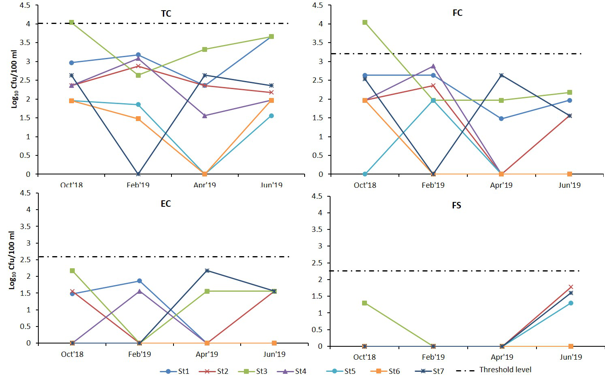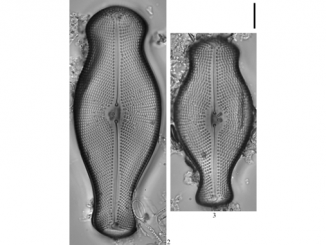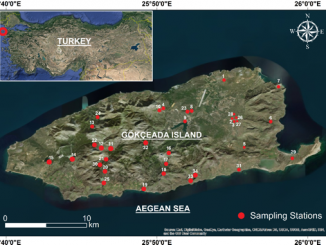
Paper category: Original research paper
Corresponding author: İbrahim Ender Künili (enderkunili@yahoo.com)
DOI: 10.2478/oandhs-2021-0025
Received: 20/01/2021
Accepted: 26/03/2021
Full text: here
Citation (APA style): Künili,İ. & Suat Ateş,A.(2021).Effects of seasonal changes and environmental factors on bioindicator bacteria levels in Çardak Lagoon, Çanakkale Strait, Turkey. Oceanological and Hydrobiological Studies,50(3) 299-309. https://doi.org/10.2478/oandhs-2021-0025
Abstract
Çardak Lagoon is one of the most important marine environments in the Turkish Strait system, which is home to a variety of organisms. The lagoon is currently under stress and faces the risk of heavy pollution. For this reason, the present state of the lagoon was monitored in this study. During sampling from October 2018 to June 2019, the levels of indicator microorganisms fluctuated up to 4.04 Log10 cfu 100 ml−1 and their presence was found to be higher in warmer seasons. The highest positive correlations were observed for total coliform levels with salinity and chemical oxygen demand, whereas the highest negative correlations were found between the levels of fecal coliforms, pH and temperature. E. coli and fecal streptococci showed moderate correlations with the environmental factors in all seasons. Although nitrite and nitrate (NO2 + NO3) were not significantly correlated with bacteria levels, they were present at elevated levels. Çardak Lagoon showed the lowest microbiological and chemical quality in the summer season, and this situation continued into the autumn season as a possible result of increased wastewater discharge and human activities. The lagoon should therefore be monitored regularly and precautions should be taken to prevent severe ecological deterioration.
Conclusion
Lagoons are important coastal areas as they provide refuge, breeding and feeding habitats for many marine species. Çardak Lagoon, one of the most important lagoons in the Turkish Strait system, has experienced chemical and bacterial pollution in recent years. In this study, bacterial contamination levels were determined seasonally and the results were related and correlated with environmental factors. It was concluded that the pollution in the lagoon originates mainly from potential human-induced discharges in and/or around the lagoon. Moreover, the pollution varied seasonally depending on changes in environmental parameters, which showed significant correlations. The results show that bacterial pollution in the lagoon is at elevated levels compared with the national and international threshold values, and if it continues at this rate, more severe deterioration of the lagoon is inevitable. For this reason, it is important that lagoons facing pollution problems, such as Çardak Lagoon, are closely monitored to protect their ecosystems and surrounding environment.
Acknowledgements
This study was conducted as part of the COST Action Project supported by TUBITAK Project #117Y510.
References
An, Y.J., Kampbell, D.H. & Breidenbach, G.P. (2002). Escherichia coli and total coliforms in water and sediments at lake marinas. Environ. Pollut. 12: 771–778. DOI: 10.1016/s0269-7491(02)00173-2.
Anastasi, E.M., Matthews, B., Stratton, H.M. & Katouli, M. (2012). Pathogenic Escherichia coli Found in Sewage Treatment Plants and Environmental Waters. Appl. Environ. Microbiol. 78: 5536–5541. DOI: 10.1128/AEM.00657-12.
Anderson, K.L., Whitlock, J.E. & Harwood, V.J. (2005). Persistence and differential survival of fecal indicator bacteria in subtropical waters and sediments. Appl. Environ. Microbiol. 71: 3041–3048. DOI: 10.1128/AEM.71.6.3041-3048.2005.
Anonymous (2006). Bathing Water Quality Directive of Turkey, Ministry of Environment and Forestry, the council directive 76/160/EU, The Official Newspaper of Turkey, No: 26048. (In Turkish).
Anonymous (2019). Regulation on the management of bathing water quality. Republic of Turkey, Ministry of Health and Ministry of Environment and Urbanization. The Official Newspaper of Turkey, No: 30899, pp: 4-19 (In Turkish).
APHA (American Public Health Association) 2005. Standard Methods for the Examination of Water and Wastewater. 21st ed., American Water Works Association/Water Environment Federation, Washington, DC, USA.
Avramidis, P., Nikolaou, K., Poulos, K., Bekiari, V. & Vantarakis, A. (2017). Environmental characterization of a Mediterranean protected shallow brackish coastal aquatic system, Klisova Lagoon, Western Greece: a case study. J. Coast. Conserv. 21: 115–125. DOI: 10.1007/s11852-016-0476-2.
Aylagas, E., Borja, A., Tangherlini, M., Dell’Anno, A., Corinaldesi, C. et al. (2017). A bacterial community-based index to assess the ecological status of estuarine and coastal environments. Mar. Pollut. Bull. 114: 679–688. DOI: 10.1016/j.marpolbul.2016.10.050.
Boukef, I., Béjaoui, B., Bel Hassan, M., Mraouna, R., Got, P. et al. (2012). Spatial Distribution and Decay Rates of Coliforms in the Sediments and Water Column of the Bizerte Lagoon. Vie et Milieu. 62: 29–36.
Cabral, J.P.S. (2010). Water Microbiology. Bacterial Pathogens and Water. Int. J. Environ. Res. Public Health. 7: 3657–3703. DOI: 10.3390/ijerph7103657.
Cataudella, S., Crosetti, D. & Massa, F. (2015). Mediterranean coastal lagoons: sustainable management and interactions among aquaculture, capture fisheries and the environment Studies and Reviews. General Fisheries Commission for the Mediterranean. No 95. Rome, FAO.
Calıskan, V., Samsa, S., Ozturk, M.Z. & Tosunoglu, M. (2011). A Proposal for the Utilization of Çardak Lagoon (Northwest Anatolia) and its Vicinity Through Wetland and Management. Management and Education. VII (3): 332–340.
Cho, K.H., Pachepsky, Y.A., Oliver, D.M., Muirhead, R.W., Park, Y. et al. (2016). Modeling fate and transport of fecally-derived microorganisms at the watershed scale: State of the science and future opportunities. Water Res. 100: 38–56. DOI: 10.1016/j.watres.2016.04.064.
Eaton, A.D. & Franson M.A.H. (2005). Standard Methods for the Examination of Water and Wastewater. 21st ed., American Water Works Association/Water Environment Federation, Washington, DC, USA.
European Commission (EC) 2006. Directive 2006/7/EC of the European Parliament and of the council of 15 February 2006 concerning the management of bathing water quality and repealing Directive 76/160/EEC, 4.3.2006 EN Official Journal of the European Union L 64/37.
Ferguson D. & Signoretto C. (2011). Environmental Persistence and Naturalization of Fecal Indicator Organisms. In: C. Hagedorn, A. Blanch & V. Harwood (Eds.) Microbial Source Tracking: Methods, Applications, and Case Studies. New York, NY: Springer. DOI: 10.1007/978-1-4419-9386-1_17.
Fiandrino, A., Martin, Y., Got, P., Bonnefont, J.L. & Troussellier, M. (2003). Bacterial contamination of Mediterranean coastal seawater as affected by riverine inputs: simulation approach applied to a shellfish breeding area (Thaulagoon, France). Water Res. 37: 1711-1722. DOI: 10.1016/S0043-1354(02)00573-0
Freeman, L.A., Corbett, D.R., Fitzgerald, A.M., Lemley, D.A., Quigg, A. & Steppe, C.N. (2019) Impacts of Urbanization and Development on Estuarine Ecosystems and Water Quality. Estuaries and Coasts. 42: 1821–1838. DOI: 10.1007/s12237-019-00597-z.
Food and Drug Administration (FDA) (1998). Bacteriological Analytical Manual. 8th Edition, Revision A. Washington DC, USA.
Gilfillan, D., Hall, K., Joyner, T.A. & Scheuerman, P. (2018). Canonical Variable Selection for Ecological Modeling of Fecal Indicators. J. Environ. Qual. 47: 974–984. DOI: 10.2134/jeq2017.12.0474.
Hassou, N., Maanan, M., Hennani, M., Zourarah, B. & Assobhei, O. (2014). Spatial and temporal variation of faecal pollution indicators (Escherichia coli and faecal streptococci) and physico-chemical parameters at the Oualidia lagoon and its watershed (Morocco). Int. J. Curr. Microbiol. Appl. Sci. 3: 675–694.
Hennani, M., Maanan, M., Robin, M., Chedad, K. & Assobhei, O (2012). Temporal and Spatial Distribution of Faecal Bacteria in a Moroccan Lagoon. Pol. J. Environ. Stud. 21: 627–634.
Hill, M.J. (2005). The normal gut bacterial flora. In: Role of Gut Bacteria in Human Toxicology and Pharmacology. Taylor & Francis, London, UK. ISBN: 0-203-27165-3.
Hong, H., Qiu, J. & Liang, Y. (2010). Environmental factors influencing the distribution of total and fecal coliform bacteria in six water storage reservoirs in the Pearl River Delta Region, China. J. Environ. Sci. 22: 663–668. DOI: 10.1016/S1001-0742(09)60160-1.
Juhna, T., Birzniece, D. & Rubulis, J. (2007). Effect of phosphorus on survival of Escherichia coli in drinking water biofilms. Appl. Environ. Microbiol. 73(11): 3755–3758. DOI: 10.1128/AEM.00313-07.
Kacar, A. & Omuzbuken, B. (2017). Assessing the seawater quality of a coastal city using fecal indicators and environmental variables (eastern Aegean Sea). Mar. Pollut. Bull. 123: 400–403. DOI: 10.1016/j.marpolbul.2017.08.052.
Kalkan, S. & Altug, G. (2015). Bio-indicator bacteria & environmental variables of the coastal zones: The example of the Güllük Bay, Aegean Sea, Turkey. Mar. Pollut. Bull. 95: 380–384. DOI: 10.1016/j.marpolbul.2015.04.017.
Kalkan, S. & Altug, G. (2020). The composition of cultivable bacteria, bacterial pollution, and environmental variables of the coastal areas: an example from the Southeastern Black Sea, Turkey. Environ. Monit. Assess. 192: 356. DOI: 10.1007/s10661-020-08310-5.
Kataržytė, M., Mėžinė, J., Vaičiūtė, D., Liaugaudaitė, S., Mukauskaitė, K. et al. (2018). Fecal contamination in shallow temperate estuarine lagoon: Source of the pollution and environmental factors. Mar. Pollut. Bull. 133: 762–772. DOI: 10.1016/j.marpolbul.2018.06.022.
Kjerfve, B. (1994). Chapter 1: Coastal Lagoons. In B. Kjerfve (Ed.) Coastal Lagoon Processes (pp. 1–8). Amsterdam: Elsevier.
Korajkic, A., Wanjugi, P., Brooks, L., Cao, Y. & Harwood, VJ. (2019a). Persistence and decay of fecal microbiota in aquatic habitats. Microbiology and Molecular Biology Reviews 83: e00005-19. DOI: 10.1128/MMBR.00005-19.
Korajkic, A., McMinn, B.R., Ashbolt, N.J., Sivaganesan, M., Harwood, V.J. et al. (2019b). Extended persistence of general and cattle-associated fecal indicators in marine and freshwater environment. Sci. Total Environ. 650: 1292–1302. DOI: 10.1016/j.scitotenv.2018.09.108.
LeChevallier, M.W. (2003). Conditions favouring coliform and HPC bacterial growth in drinking water and on water contact surfaces. In: Heterotrophic Plate Counts and Drinking-water Safety (pp.177–197). London: World Health Organization IWA Publishing, UK. ISBN: 1 84339 025 6.
Mansilha, C.R., Coelho, C.A., Heitor, A.M., Amado, J., Martins, J.P. et al. (2009). Bathing waters: New directive, new standards, new quality approach. Mar. Poll. Bull. 58: 1562–1565. DOI: 10.1016/j.marpolbul.2009.03.018.
Medema, G.J., Shaw, S. Waite, M., Snozzi, M., Morreau, A. et al. (2003). Catchment characterization and source water quality. In A. Dufour, M. Snozzi, W. Koster et al. (Eds.) Assessing Microbial Safety of Drinking Water: Improving Approaches and Methods (pp. 111–158). London: WHO OECD.
Menon, P., Billen, G. & Servais, P. (2003). Mortality rates of autochthonous and fecal bacteria in natural aquatic ecosystems. Water Res. 37: 4151–4158. DOI: 10.1016/S0043-1354(03)00349-X.
Pala, C., Molari, M., Nizzoli, D., Bartoli, M., Viaroli, P. et al. (2018). Environmental Drivers Controlling Bacterial and Archaeal Abundance in the Sediments of a Mediterranean Lagoon Ecosystem. Curr. Microbiol. 75: 1147–1155. DOI: 10.1007/s00284-018-1503-3.
Perini, L., Quero, G.M., García, S.E. & Luna, G.M. (2015). Distribution of Escherichia coli in a coastal lagoon (Venice, Italy): Temporal patterns, genetic diversity and the role of tidal forcing. Water Res. 87: 155–165. DOI: 10.1016/j.watres.2015.09.021.
Perkins, T.L., Perrow, K., Rajko-Nenow, P., Jago, C.F., Jones, D.L. et al. (2016). Decay rates of faecal indicator bacteria from sewage and ovine faeces in brackish and freshwater microcosms with contrasting suspended particulate matter concentrations. Sci. Total Environ. 572: 1645–1652. DOI: 10.1016/j.scitotenv.2016.03.076.
Rodriguez, C. & Cunha, M.A. (2017). Assessment of the microbiological quality of recreational waters: indicators and methods. Euro-Mediterranean Journal for Environmental Integration. 2: 25. DOI: 10.1007/s41207-017-0035-8.
Scialabba, N. (1998). Integrated coastal area management and agriculture, forestry and fisheries. FAO guidelines. Environment and Natural Resources Service. FAO, Rome.
Servais, P., Garcia-Armisen, T., George, I. & Billen, G. (2007). Fecal bacteria in the rivers of the Seine drainage network (France): Sources, fate and modeling. Sci. Total Environ. 375: 152–167. DOI: 10.1016/j.scitotenv.2006.12.010.
Sinton, L.W., Donnison, A.M. & Hastie, C.M. (1993). Faecal streptococci as faecal pollution indicators: A review. Part II: Sanitary significance, survival, and use. N. Z. J. Mar. Freshwater Res. 27: 117–137. DOI: 10.1080/00288330.1993.9516550.
Steele, J.A., Blackwood, A.D., Griffith, J.F., Noble, R.T. & Schiff, K.C. (2018). Quantification of pathogens and markers of fecal contamination during storm events along popular surfing beaches in San Diego, California. Water Res. 136: 137–149. DOI: 10.1016/j.watres.2018.01.056.
Strickland, J.D.H. & Parsons T.R. (1972). A Practical Handbook of Seawater Analysis. Fisheries Research Board of Canada. Ottawa, 167.
USEPA (2009). Method 1106.1: enterococci in water by membrane filtration using membrane enterococcus- Esculin iron agar (mE-EIA). US EPA Office of water, Washington DC.
World Health Organization (WHO) (2018). WHO recommendations on scientific, analytical and epidemiological developments relevant to the parameters for bathing water quality in the Bathing Water Directive (2006/7/EC).
Vega, L., Jaimes, J., Morales, D., Martinezz, D., Cruz-Saavedra, L. et al. (2021). Microbial Communities’ Characterization in Urban Recreational Surface Waters Using Next Generation Sequencing. Microbial Ecology. DOI: 10.1007/s00248-020-01649-9.
Vural, P. & Acarli, S. (2018). Assessment of Çardak Lagoon Fisheries and Aquaculture Production. International Ecology 2018 Symposium, Kastamonu, Turkey
Yetis, A.D. & Selek, Z. (2015). Determination of total and fecal coliforms of Akyatan Lagoon in terms of microbiological pollution. Arab. J. Geosci. 8: 1125–1132. DOI: 10.1007/s12517-014-1268-3.
Zafiri, C., Marazioti, C.E., Kornaros, M., Angelopoulos, K. & Lyberatos, G. (2009). The deterioration of the environmental state of the shallow Koutavos Lagoon in Kefalonia, Greece. Fresenius Environ. Bull. 18: 935–947.
Zoppini, A., Bongiorni, L., Ademollo, N., Patrolecco, L., Cibic, T. et al. (2020). Bacterial diversity and microbial functional responses to organic matter composition and persistent organic pollutants in deltaic lagoon sediments. Estuar. Coast. Shelf Sci. 223: 106508. DOI: 10.1016/j.ecss.2019.106508.
Zeki, S., Aslan, A., Burak, S. & Rose, J. (2021). Occurrence of a human‐associated microbial source tracking marker and its relationship with faecal indicator bacteria in an urban estuary. Lett. Appl. Microbiol. 72: 167–177. DOI: 10.1111/lam.13405.



